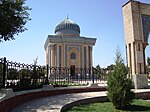
The Chishtī Order is a tariqa, an order or school within the mystic Sufi tradition of Sunni Islam. The Chishti Order is known for its emphasis on love, tolerance, and openness. It began with Abu Ishaq Shami in Chisht, circa 930 AD in a small town near Herat, a strategic city in then Eastern Persia, which later became independent and then part of Afghanistan.
Sultan-ul-Mashaikh, Mahbub-e-Ilahi, Sheikh Khwaja Syed Muhammad Nizamuddin Auliya, also known as Hazrat Nizamuddin, and Mahbub-e-Ilahi was an Indian Sunni Muslim scholar, Sufi saint of the Chishti Order, and is one of the most famous Sufis from the Indian Subcontinent. His predecessors were Fariduddin Ganjshakar, Qutbuddin Bakhtiyar Kaki, and Moinuddin Chishti, who were the masters of the Chishti spiritual chain or silsila in the Indian subcontinent.

Jamia Nizamia more properly, Jami'ah Nizamiyyah, is one of the oldest Islamic seminaries of higher learning for Muslims located in Hyderabad, India. It is named after its founder- the 7th Nizam of Hyderabad.

Imdadullah Muhajir Makki was an Indian Muslim Sufi scholar of the Chishti Sufi order. His disciples include Muhammad Qasim Nanautawi, Rashid Ahmad Gangohi, and Ashraf Ali Thanwi. In the Indian Rebellion of 1857, he led the Muslims in Thana Bhawan to fight against British.
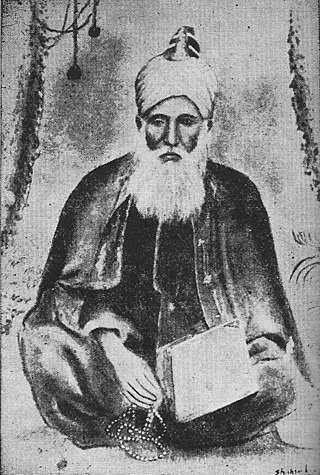
Sayyid Sāhib Ḥusayni was a famous Sufi saint from Hyderabad State, India and had a great influence over spiritual developments in the Deccan area. He belonged to Qadiri Order, and was a great proponent of the concept of Wahdat al-Shuhood.

Shah Niyaz Ahmad (1742-1834) was a Sufi, poet and author from India.
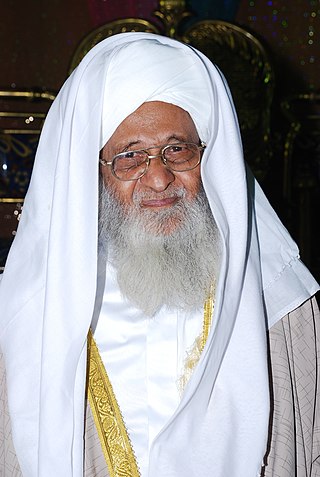
MaulanaAbdullah Quraishi Al-Azhari was an Islamic scholar from Hyderabad, India. He served as the khateeb and imam of the Mecca Masjid in Hyderabad and the vice chancellor of Jamia Nizamia University.

Abū Ibrāhīm K͟halīl Aḥmad ibn Majīd ‘Alī Anbahṭawī Sahāranpūrī Muhājir Madanī was a Deobandi Hanafi Islamic scholar from India who authored Badhl Al-Majhud Fi Hall Abi Dawud, an 18-volume commentary on the hadith collection Sunan Abi Dawud. He was also a Sufi shaykh of the Chishti order, being a disciple and successor of Rashid Ahmad Gangohi.

Khwaja Haji Dost Muhammad Qandhari was an Afghan Sufi master in the Naqshbandi tradition in the 19th century (1801–1868).

Shah Abdul Wahhab, born Shah Abdul Wahhab, also known as, was a Sunni Islamic scholar and reformer of the late 19th and early 20th Century from the southern part of India. Like Shah Waliullah Muhaddith Dehlvi he was worried about the state of Muslims of South India, especially those of Nagore and its nearby regions. He founded the Madrasa Al-Baqiyat As-Salihat in Vellore in the year 1857.
Abul Wafa Al Afghani, also known as Abu Wafa Al Afghani, was a notable Persian astronomer and mathematician. He was born in 940 CE in the province of Khorasan, which is now part of modern-day Iran.

Idris Kandhlawi was a Pakistani Sunni scholar during the mid-twentieth century, widely recognized for his contributions to various fields of Islamic studies, including hadith, Quranic studies, Islamic jurisprudence, Prophetic biography, and theology. Holding the titles of Sheikh al-Hadith and Sheikh al-Tafsir, he traced his lineage to Abu Bakr on his father's side and Umar on his mother's side. He studied in Thana Bhawan under Ashraf Ali Thanwi. He studied hadith, first at Mazahir Uloom under Khalil Ahmad Saharanpuri, and later at Darul Uloom Deoband under Anwar Shah Kashmiri. He started his professional career at Madrasa Aminia and later e went to Darul Uloom Deoband. In 1929 he took a position in Hyderabad State, where he had access to the Asafia Library. This experience enabled him to produce a five-volume Arabic commentary on Mishkat al-Masabih titled Al-Taleeq al-Sabeeh, of which the first four volumes were published in Damascus. His scholarly work garnered recognition in the Arab world. He later assumed the roles of Sheikh al-Tafsir at Darul Uloom Deoband and Sheikh al-Hadith wa al-Tafsir at Jamia Ashrafia. In addition, he served as the Chancellor of Islamia University of Bahawalpur during its tenure as Jamia Abbasia.
Zia ul Mustafa Aazmi Qadri Razvi Amjadi is an Indian Islamic scholar, teacher, orator, debater, Muhaddith and Faqih and is currently serving as Naa’ib Qaazi ul Quz’zat fil Hind under Mufti Asjad Raza Khan, who is considered to be the Grand Mufti Of India by the Barelvi movement. He has memorised over 60,000 hadith with their Isnaad, having taught Bukhari and Muslim for over five decades and producing tens of thousands of scholars, he was named by the Royal Aal al-Bayt Institute for Islamic thought as one of the 500 most influential Muslims in the world in 2016.
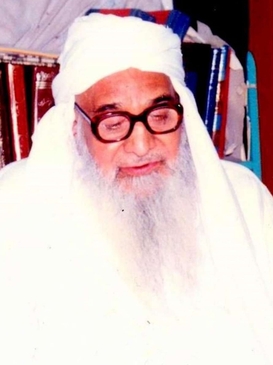
Maulana Sufi Abdul Hameed Khan Swati was a Pakistani Islamic scholar, writer, Imam, lecturer and founder of Jamia Nusrat Ul Uloom Gujranwala. He was the younger brother of Muhammad Sarfaraz Khan Safdar and uncle of Zahid Khan.
Ahmad Hasan Amrohi was an Indian Muslim scholar and freedom struggle activist who served as the first principal of Madrasa Shahi in Moradabad. He was an alumnus of Darul Uloom Deoband and among the founding members of Mahmud Hasan Deobandi's Thamratut-Tarbiyat. He was an authorized disciple of Imdadullah Muhajir Makki.

Muhammad Ibrahim Raza Khan Qadri Razvi (1907–1965), commonly known as Mufassir-e-Azam-e-Hind and Jilani Miyan, was an Indian Islamic scholar, Sufi mystic, orator, author, and leader of Sunni Muslim’s Barelvi movement of Sunni Islam in the Indian subcontinent. He was the elder brother of Hammad Raza Khan.

ʿAbd al-Wāḥid Bengālī was a 19th-century Muslim theologian, teacher and social reformer. He was one of the initiators of the Deobandi movement into Bengal, and co-founded Al-Jamiatul Ahlia Darul Ulum Moinul Islam in 1896.
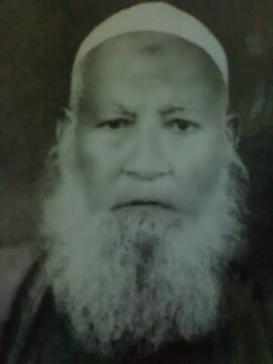
Shah Sultan Ahmad Nanupuri, also known by his daak naam Badshah, was a Bangladeshi Islamic scholar, teacher and author. He established numerous madrasas in Bangladesh and was the founding principal of Al-Jamiah Al-Islamiah Obaidia Nanupur for seventeen years.
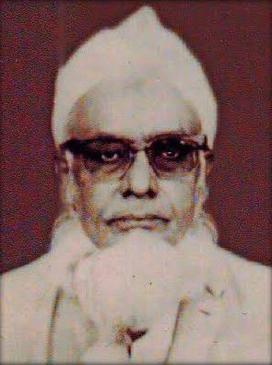
Muhammad Yunus Choudhury, popularly known as Haji Muhammad Yunus, was a Bangladeshi Islamic scholar and educationist. He was the second rector of Al Jamia Al Islamia Patiya, former president of Idarat al-Maʿarif and an active member of the Muslim World League. As the founding president of Befaqul Madarisil Arabia Bangladesh, Yunus contributed to the establishment and renovation of roughly 1500 madrasas in Bangladesh. He was awarded the title of Shaykh al-ʿArab wa al-ʿAjam by the Imam of Masjid al-Haram.

Darul Uloom Banskandi is an Islamic seminary located in the Cachar district of Assam. It is the largest Islamic university in North-East India and extremely follows the methodology of Darul Uloom Deoband.














